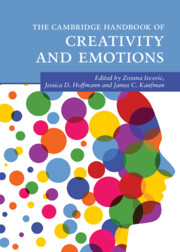Book contents
- The Cambridge Handbook of Creativity and Emotions
- Cambridge Handbooks in Psychology
- The Cambridge Handbook of Creativity and Emotions
- Copyright page
- Dedications
- Contents
- Figures
- Tables
- Contributors
- Acknowledgments
- Creativity and Emotions
- Part I Methods in the Study of Creativity and Emotions
- Part II The Development of Creativity
- Part III Emotions and the Creative Person
- Part IV Emotions and Creative Products
- Part V Emotions and Creativity at School and Work
- 24 Anxiety, Fear of Failure, and Creativity
- 25 Peers, Affect, and Creativity at School
- 26 Creative Curricular Experiences
- 27 Organizational Affective Climate and Creativity at Work
- 28 Group Affect and Creativity
- 29 Psychological Safety and Creativity
- 30 Leadership, Creativity, and Emotions
- 31 A Multilevel Model of Emotions and Creativity in Organizations
- 32 Creativity and Emotion
- Index
- References
30 - Leadership, Creativity, and Emotions
from Part V - Emotions and Creativity at School and Work
Published online by Cambridge University Press: 16 February 2023
- The Cambridge Handbook of Creativity and Emotions
- Cambridge Handbooks in Psychology
- The Cambridge Handbook of Creativity and Emotions
- Copyright page
- Dedications
- Contents
- Figures
- Tables
- Contributors
- Acknowledgments
- Creativity and Emotions
- Part I Methods in the Study of Creativity and Emotions
- Part II The Development of Creativity
- Part III Emotions and the Creative Person
- Part IV Emotions and Creative Products
- Part V Emotions and Creativity at School and Work
- 24 Anxiety, Fear of Failure, and Creativity
- 25 Peers, Affect, and Creativity at School
- 26 Creative Curricular Experiences
- 27 Organizational Affective Climate and Creativity at Work
- 28 Group Affect and Creativity
- 29 Psychological Safety and Creativity
- 30 Leadership, Creativity, and Emotions
- 31 A Multilevel Model of Emotions and Creativity in Organizations
- 32 Creativity and Emotion
- Index
- References
Summary
Effective leadership of creative people and efforts is more essential than ever, given the dynamic nature of many organizations today. Technology advances, automation, virtual work, and other workplace changes require creativity and innovation from both leaders and employees. Leaders play a critical role in fostering creativity and innovation. While a variety of attributes and capabilities have been linked to leading for creativity and innovation, less is known about the role of emotions and emotion capabilities in how leadership connects to creativity and innovation. Leader emotional displays, knowledge of emotions, and ability to recognize and regulate emotion in themselves and others have the potential to substantially influence creative work activities. This chapter explores the intersection of leadership, emotions, creativity, and innovation. Drawing on key theories and research, several questions will be examined. What is the nature of creative work and what is required from leaders to support creativity? Why are emotions important in creativity? What roles do leader emotions, traits, and displays play in fostering or hindering creativity? How does emotion regulation facilitate leader and employee creativity? What emotion preferences, skills and capabilities have been associated with different leadership styles? Challenges and theoretical implications are discussed.
- Type
- Chapter
- Information
- The Cambridge Handbook of Creativity and Emotions , pp. 577 - 597Publisher: Cambridge University PressPrint publication year: 2023



